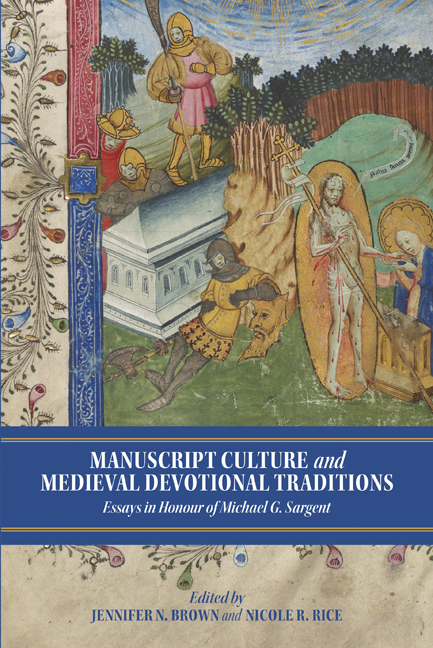Book contents
- Frontmatter
- Dedication
- Contntes
- List of Illustrations
- Acknowledgements
- List of Abbreviations
- Michael Sargent: An Appreciation
- I Manuscript Transmission and Textual Adaptation
- II Translated Texts and Devotional Implications
- III Rhetorical Strategies and Spiritual Transformations
- IV Texts and Contours of Religious Life
- Bibliography
- List of Contributors
- Michael G. Sargent’s Publications
- Index
- Tabula Gratulatoria
- York Manuscript and Early Print Studies
1 - Beinecke MS 317 and its New Witness to the Latin Door Verses from London Charterhouse: A Story of Carthusian and Birgittine Literary Exchange
Published online by Cambridge University Press: 24 March 2021
- Frontmatter
- Dedication
- Contntes
- List of Illustrations
- Acknowledgements
- List of Abbreviations
- Michael Sargent: An Appreciation
- I Manuscript Transmission and Textual Adaptation
- II Translated Texts and Devotional Implications
- III Rhetorical Strategies and Spiritual Transformations
- IV Texts and Contours of Religious Life
- Bibliography
- List of Contributors
- Michael G. Sargent’s Publications
- Index
- Tabula Gratulatoria
- York Manuscript and Early Print Studies
Summary
In 2008, Michael Sargent and Marlene Villalobos Hennessy published an essay, ‘The Latin Verses over the Cell Doors of London Charterhouse’, where they identify and discuss the Latin poems that accompanied the alphabetic designations of the twenty-five cells of London charterhouse, founded in 1371 just outside the city proper. The monastery's remarkable surviving water distribution map, dated around 1430, identifies each cell with a letter, A–Z, beginning on the western wall and proceeding around the cloister to the north (Figure 1). Sargent and Hennessy's research reveals that each identifying letter began a verse of two or three lines linked with that cell. The acrostic verses were likely painted on or above the cell doors, as the two stone door cases which survive have no evidence of carved letters.
As architectural decoration these poems would have been a strong presence in the monks’ everyday lives in the cloister, visible and readable every time they moved around the charterhouse. We know of the verses only because they were copied down in manuscripts, so they also functioned as meditative texts to be contemplated in stationary solitude. Themes covered include the solace of the monastic cell, the nature of solitary prayer, the temptations of the world, the ephemerality of life, the inevitability of death, the promise of heaven and, above all, devotion to God. The acrostic lines carry a manifold significance for our growing understanding of charterhouse culture: they contribute to ‘defining the spirituality of the English Carthusian monks during the late-medieval period’, specifically with their insights into charterhouse visual culture, mnenomic techniques and devotion and monastic subjectivities. In sum, the verses and their manuscript and architectural contexts illuminate, in Sargent and Hennessy's words, the ‘Carthusian monastic imaginary: those common beliefs and practices that characterize the vocation and corporate identity of members of the order’. While much work remains to follow up the breakthrough literary analysis of the verses themselves as offered in their 2008 article, my essay will turn to more codicological concerns – and a new manuscript discovery.
Sargent and Hennessy discuss the four manuscript witnesses of these verses that were known to them. London, British Library, MS Sloane 2515 was written by John Blacman (d. 1485) not long after his unsuccessful novitiate at London charterhouse, which occurred sometime between 1459 and 1463.
- Type
- Chapter
- Information
- Manuscript Culture and Medieval Devotional TraditionsEssays in Honour of Michael G. Sargent, pp. 3 - 24Publisher: Boydell & BrewerPrint publication year: 2021

